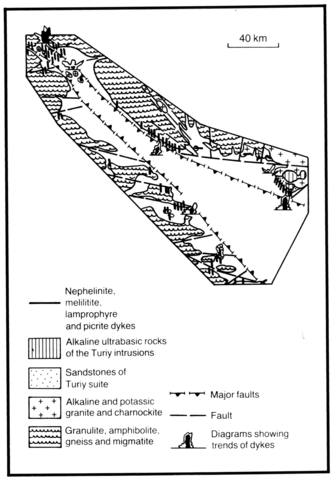stripes
Dykes and explosion pipes of alkaline ultramafic and alkaline lamprophyric rocks are widespread on the coast and islands of Kandalaksha Bay at the northwestern end of the White Sea. The dykes form swarms with a general north-south trend, a direction normal to the axis of the Kandalaksha graben (or palaeorift). The most intensive dyke swarms are the Kandalaksha and Tur'insk groups, which are also the most intensively studied. In the vicinity of the town of Kandalaksha and on the coast at the head of Kandalaksha Bay three systems of dykes can be distinguished which trend approximately north (0-30o), northeast (50-60o) and east (80o). The dykes have a vertical or very steep dip and two age groups have been recognised. The first group is older than the dykes associated with the Turiy intrusion (No 25). They include lamprophyric carbonatites, alkaline picrites, monchiquites, olivine melilitites and carbonatites. From dyke intersections the picrites prove to be older than the monchiquites. The carbonatites are younger than the alkaline lamprophyres and picrites. All the dykes are choked with xenoliths derived from the enclosing rocks. Dykes of the second age group are represented, in order of decreasing age, by alkaline picrites, monchiquites, limburgites, camptonites, fourchites, melanephelinites, nephelinites, microshonkinites andalkaline syenite porphyries. They correspond to the third group of dykes on the Turiy peninsula, but differ from those by the presence of plagioclase-bearing rocks, notably camptonites; melilite-bearing varieties are not represented and neither are carbonatites. In an alluvial layer derived from the Romanenko pipe, concentrations are found of transparent crystals of olivine, perovskite, chromite, chrome-diopside, orange almandine, pyrope and purple dichroic pyrope. Dichroic pyropes were also found in heavy concentrates derived from picrites. On Telyachiy Island, which is also situated in the most northerly part of Kandalaksha Bay, a dyke of augite-biotite monchiquite has been located that contains a breccia with a conglomerate-like structure, that is, in places, intensely carbonated. It is similar in composition and morphology to the "boulder" dykes of the Turiy peninsula. According to Dr Hillary Downes (pers. comm., 1993) it is a carbonatite dyke with xenoliths of carbonatite and amphibole-phlogopite-pyroxene rocks.
BULAKH, A.G. and IVANNIKOV, V.V. 1984. Problems of mineralogy and carbonatite petrology. Leningradskii Gosudarstvennyi Universitet, Leningrad. 242 pp.
KURILEVA, N.A. and NOSIKOV, V.V. 1959. Volcanic eruptive pipes on the Kola Peninsula. Razvedka i ohrana nedra, 3: 5-8.
PUTINTSIVA, E.V. and UVADIEV, L.I. 1987. On the evolution of dyke magmatism of the Kandalaksha shield (Kola peninsula). In Magmatism, metamorphism and geochronology of the west-east Precambrian platform. 91-3. Akademii Nauk SSSR, Kola Branch, Petrozavodsk.
SHURKIN, K.A. 1960. On Kandalaksha conglomerates of Turij Mys. Works of the Precambrian Laboratory of the USSR, 9: 398-411.

